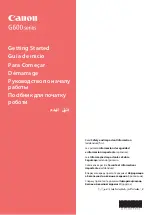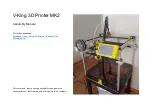
9
Material Safety Data Sheet
# 58342801
(Type C2 Magenta Toner, P/N 41304206)
#58343201
(Type C3 Magenta Toner, P/N 41515206)
For more information, contact Oki Data at 2000 Bishops Gate
Blvd., Mount Laurel, NJ, 08054-4620
Emergency Information: Call 1-800-654-3282; US & Canada
Only
Emergency First Aid Procedures
Toner swallowed (ingested).
Immediately seek medical attention.
Toner inhaled.
Remove person to fresh air. Seek medical attention. If not
breathing, give artificial respiration. If breathing is difficult, give
oxygen.
Toner gets in the eyes.
Flush eyes with large quantities of cool water for 15 minutes,
keeping the eyelids open with fingers. Seek medical attention.
Toner gets on the skin.
Wash toner off the skin with plenty of cool water and soap. If
necessary, seek medical attention.
!
Small amounts of toner on skin or clothing can easily be
removed with soap and cold water. Hot water makes toner
harder to remove.
Hazardous Ingredients
Amorphous Silica (less than 3% by weight)
CAS# 7631-86-9
NIOSH TWA 6 mg/m
3
Note: This product is not hazardous under OSHA 29 CFR
1910.106, nor under DOT 49 CFR 172.101. This
product is not regulated under Section 302 or 313 of
SARA, nor under CERCLA.
Physical Data
Melting Point: 105 to 115°C (221 to 239°F)
Boiling Point: Not available
Vapor Pressure: Not available
Vapor Density (Air=1): Not available
Evaporation Rate (Butyl Acetate=1): Not available
Specific Gravity (H
2
O=1): 1.2 at 20°C (68°F)
Solubility in water: Insoluble
Appearance and odor: Magenta powder, no odor
Fire and Explosion Hazard Data
Minimal fire hazard.
Flash Point (Method Used): Not applicable
Flammable Limits
Lower Explosive Limit: Not applicable
Upper Explosive Limit: Not applicable
Extinguishing Media: CO
2
or Dry Chemical for small fires.
Alcohol-resistant or all-purpose type foams for large fires.
Special Fire Fighting Procedures: Fight fire from upwind
position. Wear self-contained breathing apparatus.
Unusual Fire & Explosion Hazards
Hazardous Combustion Products: Carbon monoxide, carbon
dioxide, oxides of nitrogen.
Health Hazard Data
Routes of Entry: Inhalation, Ingestion, Eyes, Skin.
Amorphous Silica
IARC:Monograph 68, 1997; Group 3 “Not Classifiable”
Reactivity Data
Stability: Stable
Stability: Stable.
Conditions to Avoid: Avoid excess heat and all sources of
ignition.
Polymerization: Will not occur.
Hazardous Decomposition Products: Thermal decomposition
may result in release of oxides of carbon and nitrogen.
Incompatibility: Not available.
Spill Cleanup and Disposal
Spill Cleanup
Small Spills
1 Remove sources of ignition.
2 Clean up spill with wet cloth.
Large Spills
1 Remove sources of ignition.
2 Keep unnecessary and unprotected personnel away from
area.
3 Wear protective gear: respirator, rubber gloves, goggles (see
below)
4 Mix the spilled material with moist absorbent and scoop it
into a suitable waste container. This material is
non-hazardous under RCRA.
Waste Disposal
Prevent release of material into natural waters and sewers.
Follow appropriate federal, state and local regulations.
Safe Handling and Use
Respiratory Protection: Not normally required. For large spills,
use NIOSH-approved full face-piece respirator with HEPA
cartridge during cleanup.
Protective Gloves and/or Eye Protection: Not normally
required. For large spills, use rubber gloves and chemical
worker’s goggles during cleanup.
Ventilation: Outside of normal ventilation, not normally
required.
Prepared 1/1/01






























